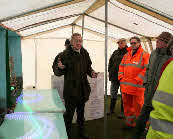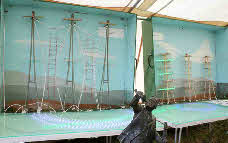AN UPDATE
As previously described, an International fund-raising appeal had been launched to
commemorate the father of radar, Sir Robert Watson-Watt, with a memorial in his hometown
of Brechin in Angus, Scotland. The Charity Regulator has accepted the fund as a
Registered Charity. I have recently been informed by the Treasurer of the Watson-Watt
Society of Brechin, Peter Grace, that some progress has been made to-wards their
goal of £60,000 to provide a suitable memorial. But they still have a long way
to go to achieve their aim and they have issued a fresh appeal for funds to assist
them. A number of fund raising events and other activities have already taken place
and will continue for some time yet. The Society has recently commissioned a Maquette.
This is a bronze statuette model of the proposed Sir Robert Watson-Watt’s memorial
(shown on previous page) and went on display in Brechin Public Library from Tuesday
1 December 2009. It is a beautiful piece of art by Alan Herriot. The Maquette
will also be on view, from time to time, at displays throughout the country. It
was recently taken by the before mentioned Peter Grace of the Watson-Watt Society
of Brechin, to be displayed at the field just outside the town of Weeden, near Daventry
where the original 26 February 1935 test and demonstration of radar was carried
out and where a successful re-enactment took place on Saturday 26 February 2010
to mark the 75th Anniversary of the original. The re-enactment proved to be very
successful.
The Original 1935 Test and Demonstration
Readers will recall from pages one and two, that the Committee for the Scientific
Study of Air Defence asked for a demonstration and apart from Watson-Watt and his
assistant Arnold Wilkins, A. P. Rowe (who was the Secretary of the Committee) was
the sole outside observer at the demonstration on 26 February 1935 where it was arranged
that a Handley Page Heyford bomber should fly at a height of 2000 m to and fro in
the main beam of the BBC Empire short-wave transmitter at Daventry which radiated
10 kW at 49.8 m. A simple but sensitive arrangement was used to look for reflections
from the aircraft. At a distance of 10 km from the transmitter two horizontal half-wave
dipoles were mounted on poles; the dipoles were lined up with the transmitter and
were spaced 25 m apart. The two dipoles had to be a half wave apart to cancel the
signal from the transmitter. By means of a phase changer and two receivers the signals
from the two dipoles were applied in phase opposition to a cathode-ray tube so that
signals arriving directly from the transmitter produced no deflection; signals reflected
from an aircraft, arriving at a different angle, were not cancelled and produced
a vertical deflection on the tube. They saw signals reflected from the aircraft
for about 4 minutes on three occasions as the aircraft passed overhead. Watson-Watt
must have been rather disappointed that Rowe didn't jump up and down with joy; in
his account of the show he notes that Rowe showed 'no detectable signs of excitement
or elation'. However he needn't have worried, Rowe gave him a green light in his
report to the Tizard Committee; he wrote:
'It was demonstrated beyond doubt that electromagnetic energy is reflected from the
metal components of an aircraft's structure and that it can be detected. Whether
aircraft can be accurately located remains to be shown. No one seeing the demonstration
could fail to be hopeful of detecting the existence and approximate bearing of aircraft
approaching the coast at ranges far in excess of those given by the 200 ft (sound)
mirrors.'
The Re-enactment on 26 February 2010
A team, comprising radio amateurs, from the Coventry Amateur Radio Society &
The Northampton Radio Club with many other people including the pilots of the aircraft
who are all radio amateurs were successful in the re-enactment of the test and demonstration
of 75 years previously. The demonstration was re-enacted in the field on the site
of the Birth of RADAR Memorial Stone. This memorial stone, with the replica vehicle
& replica receiving antennas in the background are shown here(below). Note the pool
of water in the bottom left. The field was very wet indeed and in the original test
and demonstration, the 1935 vehicle reportedly did get stuck. However on the day,
the group managed with many pushing, to locate the replica vehicle successfully.
The independent witnesses included the farmer Helen Brodie and local villagers who
gave a round of applause as the trace on the oscilloscope moved due to the reflections
of the 2 metre signal from GB75RDF at Daventry. It is by the good grace of Helen
Brodie (the farmer) that the group were able to use the field. Her immediate reaction
was to indicate that her father, who owned the land in 1935, always thought "It was
great honour that this took place on my land".
So how was it done?
Well, the original principals were copied. A signal on 2 metres transmitted from
Daventry, was received with a phased array built by a local SWL. This signal was
fed to a vintage NDI HC1400 giving the dc output from the AGC line, applied to the
Y plates of an oscilloscope that gave vertical movement of the spot when an aircraft
was present, the movement being due to reflections from the aircraft – simple now,
but not so in 1935!! The original experiment was, of course, carried out on the 49-metre
short wave band and not on 2 metres. Without the pilots & aircraft the group would
have not had the successful result that was achieved. The pilots involved were all
radio amateurs, viz G4FQI, G4FKK, G0TCA and G4FPN. G4FQI came in the twin from East
Midlands Airport, G4FKK & G0TCA from Biggin Hill and G4FPN from Wellesbourne near
Stratford on Avon. All flying was at their own considerable expense on the day for
which the group is greatly indebted. Peter Grace, who is the treasurer of the Watson-Watt
of Brechin Society, took his Chain Home model along with the Maquette of the proposed
Sir Robert Watson-Watt memorial to the re-enactment and gave a lecture about the
Chain Home system. Peter was trained at the RAF Technical College on the Type 1
radar-the RDF of the Chain Home- and in his day, was one of the youngest people to
have supervised the calibration of a Type 1 radar (at RAF Sennen in 1956). After
that, he worked at RRE Malvern and for Decca Radar. Here is Peter giving his talk
on RADAR history and the Chain Home Radar system (left and right below). His models
of the Chain Home, together with the Maquette in the foreground, is shown in more
detail below on display at the re-enactment. According to the organizer this was
one of the highlights of the day.


Appeal
To return, however, to the main message of this report, and whilst it is appreciated
that the current economic difficulties make ‘giving’ to such a charity difficult,
I would nevertheless urge readers to try and make a contribution to the fund and
so make the Memorial a reality. Please follow this link to the Watson-Watt of
Brechin Society Web Site to initiate a donation:
http://www.watsonwatt.org/index.htm








